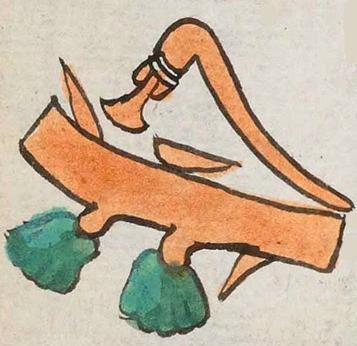xima (Mdz10v)
This simplex glyph, showing the action of the verb relating to wood working (xima), also stands for the place name Tlaximaloyan. The tla- (indefinite non-personal object), the -lo- (passive), and the -yan locative suffix are not shown visually. What is shown is a nearly horizontal tree trunk with two branches with green foliage. On the top side of the trunk is an ax or hatchet of the type called a tepoztli elsewhere. Two chips of wood, presumably the result of the action of chopping, lie on top of the trunk, and one appears below it. The trunk, wood chips, and the ax are all painted a terracotta color. The ax handle is bent or curved, forming something of an L shape. The blade is tied onto the smaller part of the L. The blade has a curve to the cutting side. It is probably copper.
Stephanie Wood
See examples of axes and other examples of the verb xima below, right.
Stephanie Wood
Stephanie Wood
c. 1541, or by 1553 at the latest
Stephanie Wood
chopping, chipping, planing wood, nombres de lugares

cortar, astillar
Stephanie Wood
Codex Mendoza, folio 10 verso, https://digital.bodleian.ox.ac.uk/objects/2fea788e-2aa2-4f08-b6d9-648c00..., image 31 of 188.
The Bodleian Libraries, University of Oxford, hold the original manuscript, the MS. Arch. Selden. A. 1. This image is published here under the UK Creative Commons, “Attribution-NonCommercial-ShareAlike 3.0 License” (CC-BY-NC-SA 3.0).





